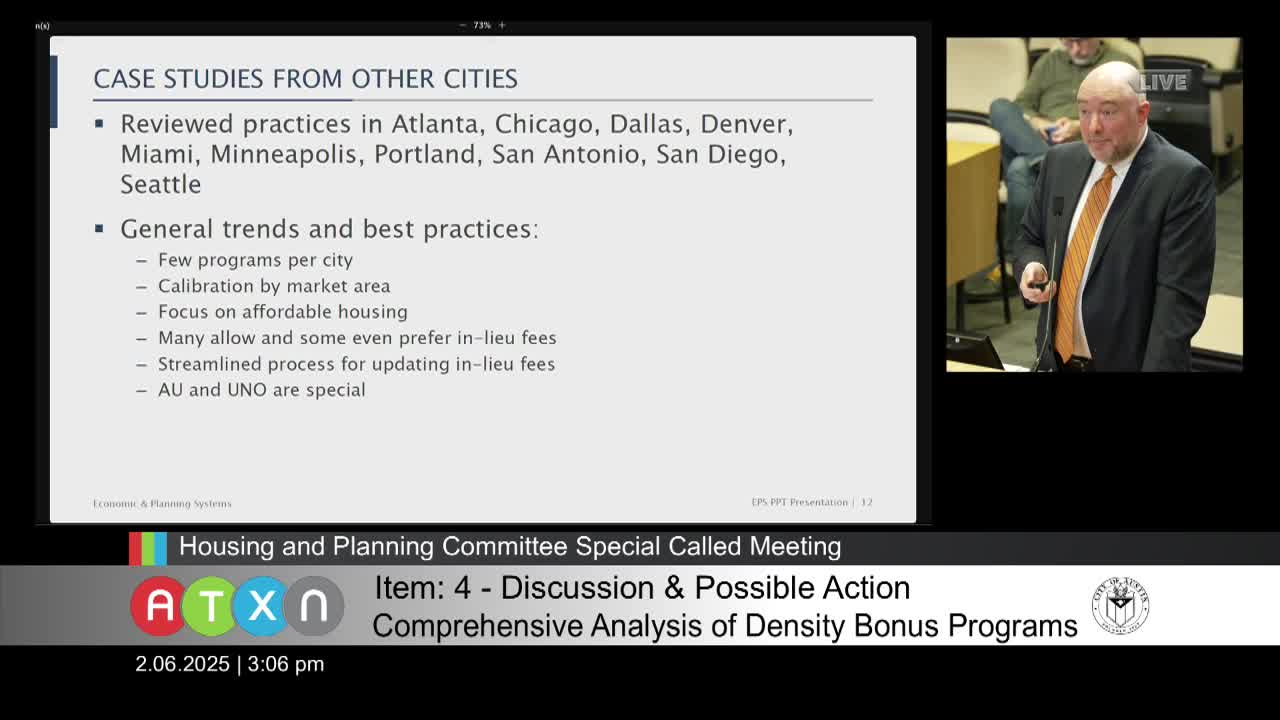Austin's UNO program hailed as a model for affordable housing strategies
February 06, 2025 | Austin, Travis County, Texas
This article was created by AI summarizing key points discussed. AI makes mistakes, so for full details and context, please refer to the video of the full meeting. Please report any errors so we can fix them. Report an error »

In a recent meeting of the Austin Housing and Planning Committee, city officials and experts gathered to discuss innovative strategies for addressing the pressing issue of affordable housing in the city. The atmosphere was charged with a sense of urgency as members explored the potential of in lieu fees—monetary contributions developers can make instead of providing affordable units on-site. This approach, favored by some, allows funds to be directed toward areas with greater housing needs, creating a ripple effect of support across the community.
The discussion highlighted Austin's unique programs, particularly the UNO initiative, which focuses on densification and affordability. Experts noted that these programs have become a national case study, showcasing effective strategies that other cities could emulate. However, they emphasized the importance of legal guidance in navigating the complexities of housing legislation, urging the committee to seek comprehensive legal reviews to ensure compliance and effectiveness.
One of the key recommendations was to streamline the various housing programs in Austin. Currently, multiple initiatives exist that serve similar purposes, particularly in transportation corridors and contiguous neighborhoods like Downtown and Rainey Street. The committee was encouraged to consider consolidating these programs to enhance clarity and efficiency.
Another significant point of discussion was the flexibility in setting affordable housing requirements. Experts suggested allowing developers to meet affordability targets through a mix of income levels rather than a one-size-fits-all approach. For instance, instead of mandating that all affordable units be priced at 60% of the median income, a more diverse range could be offered, such as some units at 50% and others at 70%. This flexibility could encourage developers to participate more actively in creating affordable housing.
The committee also acknowledged the challenges of predicting the benefits of various housing initiatives beyond just affordable units. As the conversation unfolded, it became clear that focusing primarily on affordable housing would align Austin with the practices of other successful communities.
As the meeting concluded, the committee left with a renewed sense of purpose, armed with actionable insights and recommendations. The path forward for Austin's housing landscape appears to be one of innovation and collaboration, with the potential to create a more inclusive and affordable city for all its residents.
The discussion highlighted Austin's unique programs, particularly the UNO initiative, which focuses on densification and affordability. Experts noted that these programs have become a national case study, showcasing effective strategies that other cities could emulate. However, they emphasized the importance of legal guidance in navigating the complexities of housing legislation, urging the committee to seek comprehensive legal reviews to ensure compliance and effectiveness.
One of the key recommendations was to streamline the various housing programs in Austin. Currently, multiple initiatives exist that serve similar purposes, particularly in transportation corridors and contiguous neighborhoods like Downtown and Rainey Street. The committee was encouraged to consider consolidating these programs to enhance clarity and efficiency.
Another significant point of discussion was the flexibility in setting affordable housing requirements. Experts suggested allowing developers to meet affordability targets through a mix of income levels rather than a one-size-fits-all approach. For instance, instead of mandating that all affordable units be priced at 60% of the median income, a more diverse range could be offered, such as some units at 50% and others at 70%. This flexibility could encourage developers to participate more actively in creating affordable housing.
The committee also acknowledged the challenges of predicting the benefits of various housing initiatives beyond just affordable units. As the conversation unfolded, it became clear that focusing primarily on affordable housing would align Austin with the practices of other successful communities.
As the meeting concluded, the committee left with a renewed sense of purpose, armed with actionable insights and recommendations. The path forward for Austin's housing landscape appears to be one of innovation and collaboration, with the potential to create a more inclusive and affordable city for all its residents.
View full meeting
This article is based on a recent meeting—watch the full video and explore the complete transcript for deeper insights into the discussion.
View full meeting
